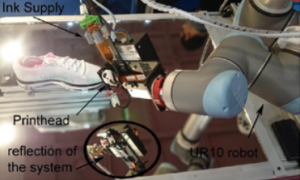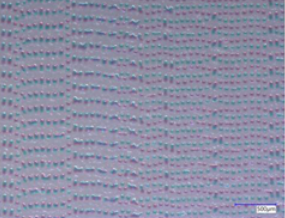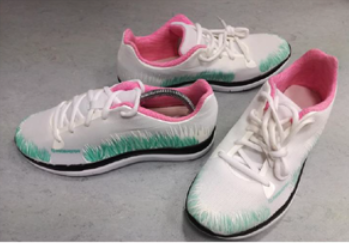So far, 3D creators have experimented with hydrographics, ultrasonic misting, and water marbling as ways to make Fused Filament Fabrication (FFF)-created objects more visually interesting. Now, an Austrian-based group is experimenting with using inkjet printing robots to beautify designers’ creations. The combination of FFF for dimensional accuracy as well as toughness and inkjet for aesthetics could be a very powerful one indeed.
In a paper from the 2018 Fraunhofer Direct Digital Manufacturing Conference in Berlin, the team detailed their efforts in developing a robot that can recognize and stylize curves like an expert artist. This robot would then apply inkjet inks to existing prints.
Current Methods for Putting Designs on FFF Surfaces
Currently, the most common options for beautifying 3D printed objects are using lasers, hot air, or chemical or mechanical processes. But since 3D printing and inkjet printing are both digital processes, using the latter would allow different designs to be applied to each unique object, and potentially on a large scale.
While this seems straightforward enough, inkjet printing is a particular challenge on 3D objects with curved surfaces. Of several proposed solutions to overcome this problem, the group first took action with developing a robot-powered Inkjet system.
Design Details
For the robot’s hardware, the team decided on a Dimatix Printer with Ricoh Gen 4 printing head. This printhead was chosen for its ability to be used in a tilted position (essential for printing on a curved surface), integrated ink heating system, and its compact dimensions. The head’s smaller size allowed for better control between the printing head and the printing surface.
Images were prepared for the robot using a software module that converted vector graphics into raster graphics. Raster images are those made up of a rectangular grid of pixels and are the opposite of vector graphics, which are made up of lines, curves, and 2D points. Once the graphics’ resolutions were converted, color channels separated, and color management processes executed, printing with the robot could begin.
Test Results
First, the system’s movement was tested by printing on a flat polymeric foil. Due to vibrations in the robot’s movement, the printed droplet design did not come out perfectly straight (as desired) and each line was slightly different based on the color used.
This is due to the Ricoh Gen’s nozzle design that has nozzle row 2 resting between nozzle row 1. These distinct rows can be supplied with different colors of ink, however the spacing between rows (about 529μm) means that ink is not jetted at the same time. While the result was not perfect, the team noted that the configuration was still serviceable and that “encouraging results could be obtained” with it.
For printing on a 3D object, the team chose to decorate a tennis shoe with a grass-like pattern on the toe and inner and outer quarters. Using the same printhead mounted on a Universal Robots UR10, Stäubli, and Kuka robot systems, the end product was encouraging, if not vaguely reminiscent of the T-shirt spray art you see in kiosks at your local mall.
The team noted too that while this configuration was functional enough, it was far from optimal as it involved near constant movement of the printhead’s orientation, often far from the ideal 90° sideways position.
The Future of 3D Inkjet Robots (and of Art?)
While it still might be some time before we see vivid and beautiful ink designs on complex and curvy 3D printed surfaces, the early results are encouraging. Like with 3D printing itself, the possibilities are limitless, and it’s not too hard to imagine that inkjet printing onto FFF objects could become a whole other art form in and unto itself. One could also use inkjet heads to apply conductive materials, coatings and perhaps even entire electronics to existing FFF parts. By combining the toughness, strength, low cost and durability of FFF parts with the ability of inkjet to add many different kinds of inks this process could fundamentally revolutionize 3D printing. By separating out the process into two steps we could see functional parts with consumer-friendly esthetics emerge. This is a huge step forward for 3D printing and many more teams should look at seeing their 3D printing challenge as something that could be solved with multiple technologies instead of just one.
Until then, the Austrian crew (and probably many like it) are optimizing each step and component of their process. They’ll also, of course, be doing a lot of testing until they have their state of the art process down to a fine art.
Source: DDMC
Subscribe to Our Email Newsletter
Stay up-to-date on all the latest news from the 3D printing industry and receive information and offers from third party vendors.
You May Also Like
Gorilla Sports GE’s First 3D Printed Titanium Cast
How do you help a gorilla with a broken arm? Sounds like the start of a bad joke a zookeeper might tell, but it’s an actual dilemma recently faced by...
Nylon 3D Printed Parts Made More Functional with Coatings & Colors
Parts 3D printed from polyamide (PA, Nylon) 12 using powder bed fusion (PBF) are a mainstay in the additive manufacturing (AM) industry. While post-finishing processes have improved the porosity of...
$25M to Back Sintavia’s Largest Expansion of Metal 3D Printing Capacity Since 2019
Sintavia, the digital manufacturing company specializing in mission-critical parts for strategic sectors, announced a $25 million investment to increase its production capacity, the largest expansion to its operations since 2019....
Velo3D Initiates Public Offering in a Bid to Strengthen Financial Foundations and Drive Future Growth
Velo3D (NYSE: VLD) has been among a number of publicly traded 3D printing firms that have attempted to weather the current macroeconomic climate. After posting a challenging financial report for 2023,...



































